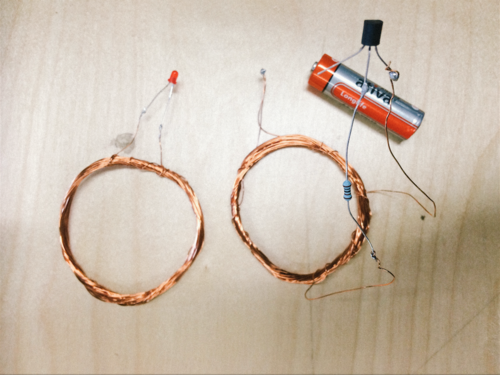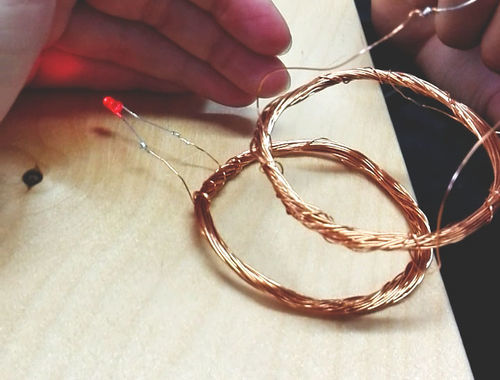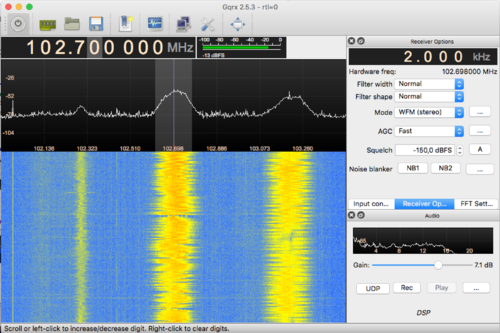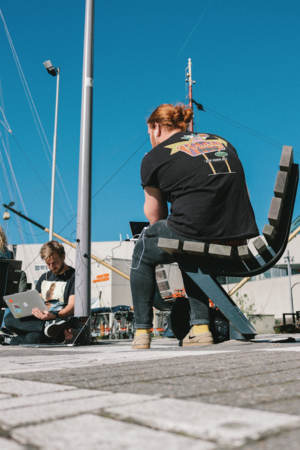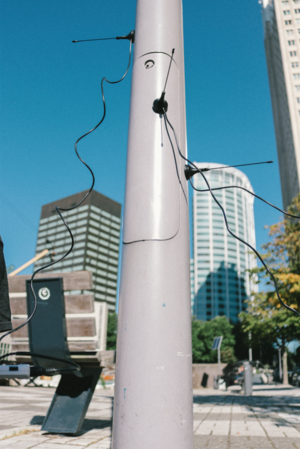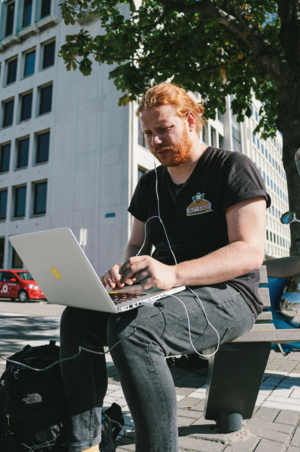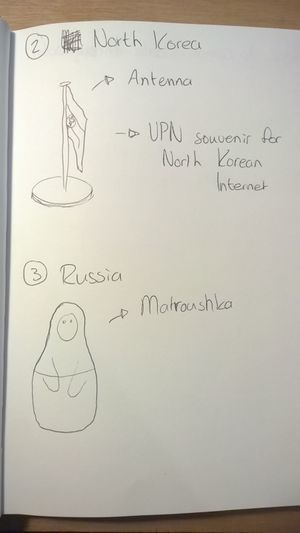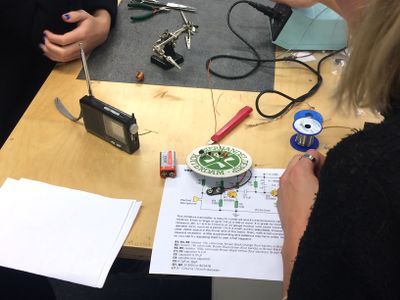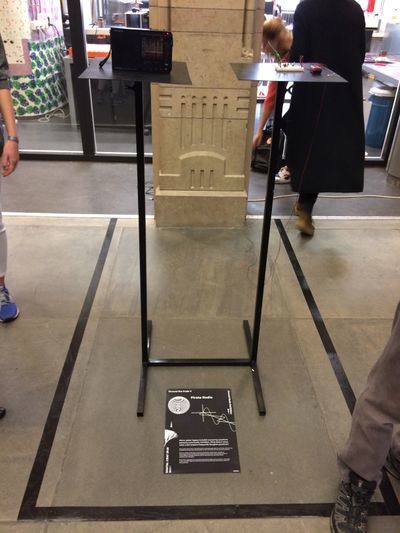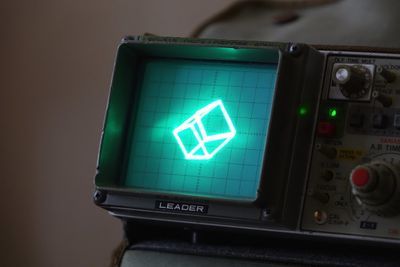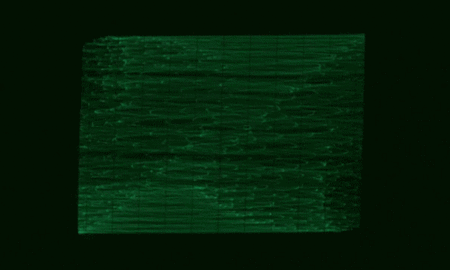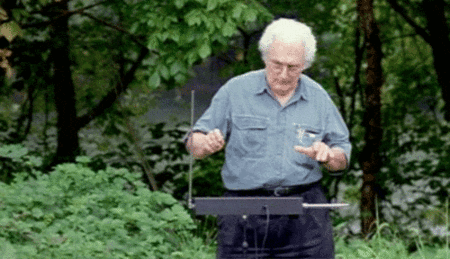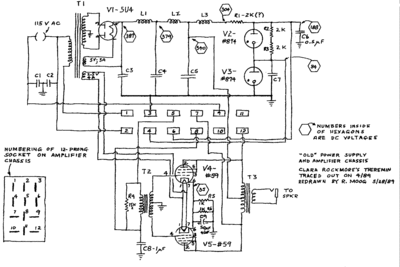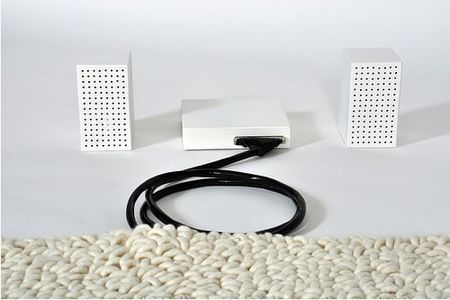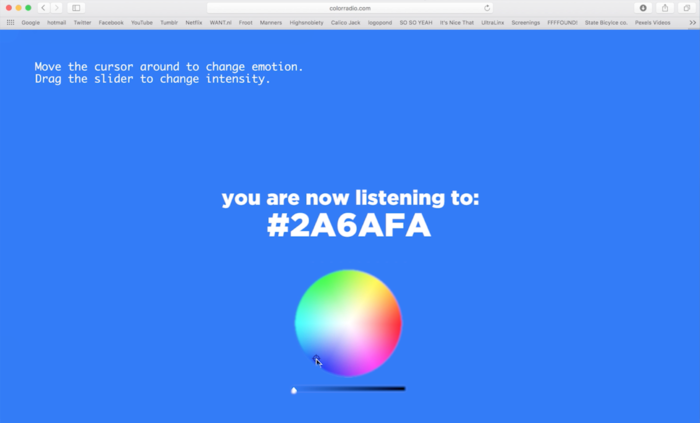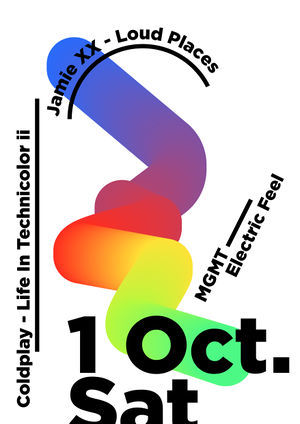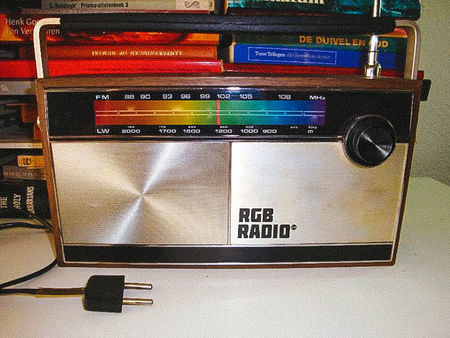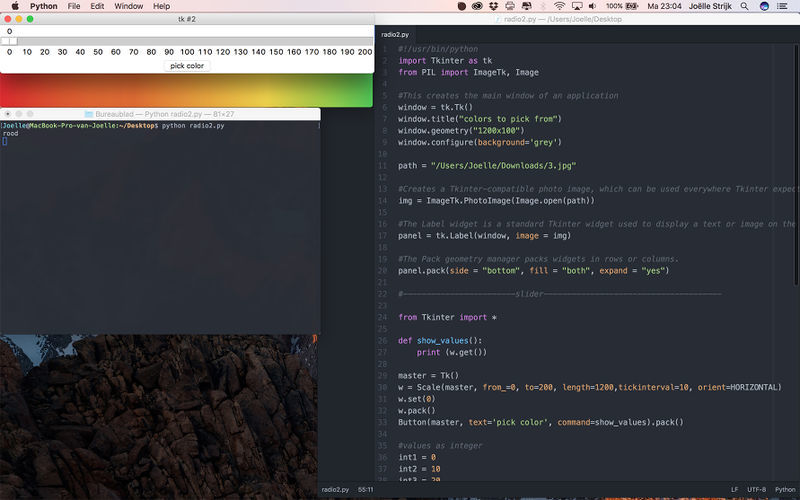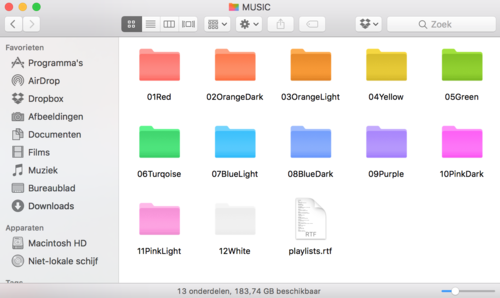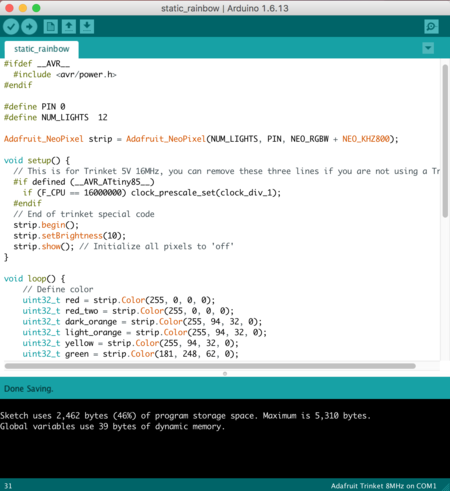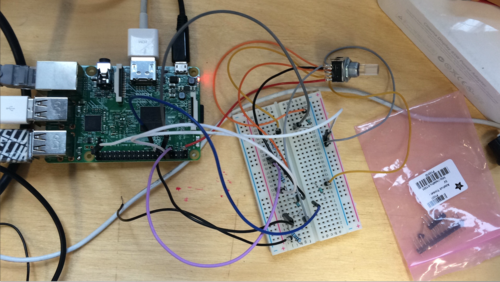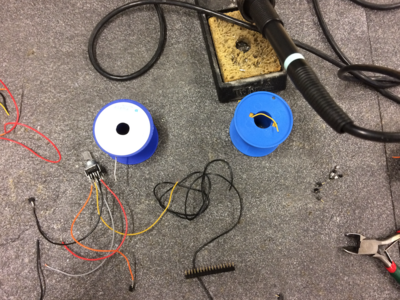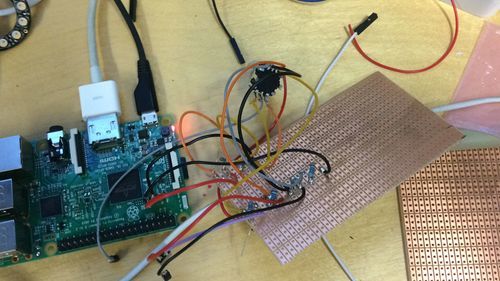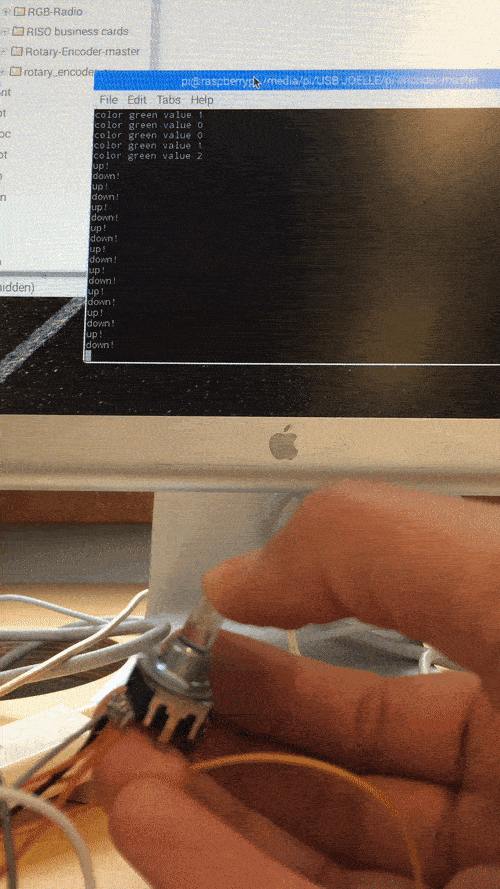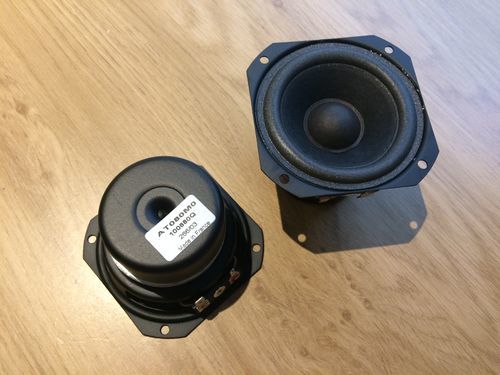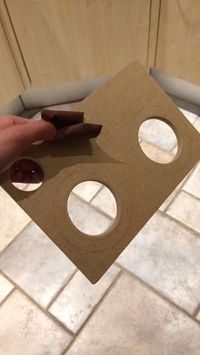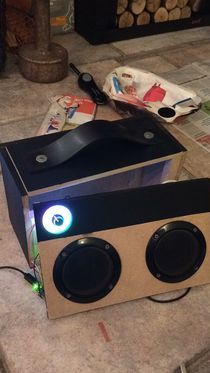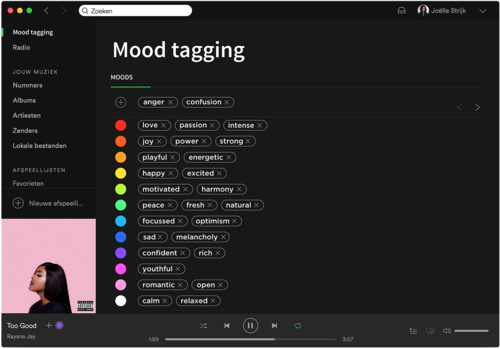User:0902492
Contents
Joëlle's Wiki Q9
As a 3rd year graphic design student with a pretty 'commercial' style and mindset in terms of my own design practice, I picked Digital Craft to broaden my horizon. I've done some open aanbod and electives in the Interaction Station before and really liked the technical part of it.
So this quarter it was time to challenge myself some more. I had a few goals in mind:
- experiment with different techniques
- make something physical
- work on coding (Python)
Workshops
I quickly discovered that the workshops were actually a great way to check the first item of my list: experimenting. It isn't just for experimenting with different techniques, but also materials. Like with any experiment the workshops are a trial and error type of thing. Sometimes things are quite easy to pull of but more often they're not. But that makes the satisfaction of getting something to work only bigger.
Wireless LED
This workshop we worked with pretty basic materials as you can tell from the picture. Nevertheless we had some struggles making it work. I worked on it together with Jeroen and Sanne and after double-checking everything and adjusting some things we got it to work.
SDR dongle + Gqrx
Played around with this small device one for quite some time. Setting up the dongle wasn't the hardest part, just plug and play. But finding the right settings with the Gqrx program was a bit more difficult. I first of tried a bunch of things myself, it made me more familiar with the interface and how it worked but I couldn't get a clear signal yet. After some research on Google I managed to listen to the radio (something I don't really do much anymore ever since Spotify).
When I went outside together with Jerry and Mattijn things became more exciting (again also more difficult). This time we were trying to find some 'private' channels. After quite some time I was suddenly tuned in to what seemed like two truckers talking to each other. I recorded a part of the conversation. Listening to the two making some small talk and gossiping about work was actually pretty entertaining.
Imaginary Radio
For the Imaginary Radio we had to come up with something for the 1800's. We had the idea of placing an installation people could enter in Amsterdam. Inside the installation would be a small projector which would play a recording of Paris on loop. Meanwhile there would be playing live audio imitation the sounds of the video. This way we created some sort of the first '(not-so-)live stream' for that time. People could really experience both visually as well as audibly what it would be like in a foreign city hundreds of kilometers away.
We had to further work on a concept of a different team. Their concept was that a souvenir you took home with you from a different country would be able to unlock certain memories of the place you took it from. We decided to take a matryoshka doll and implement it with a NFC chip. Unfortunately we didn't had one at that point in time, so we decided to use a QR-code instead. It needed to be a bit secretive so we placed a small QR-code on the bottom of the very last matryoshka doll. If you scanned the QR-code you would be taken to Kproxy, a website that offers a free anonymous web proxy service. Through that site you would be taken to a, in this case, Russian security camera in public space which is linked to the place you supposedly bought your matryoshka doll souvenir.
 WdKA meets MICA
WdKA meets MICA 
Pirate Radio. That was our assignment. Did any of us ever build a FM transmitter before? No. Did we knew how it worked? No. Was the site containing information on how to do it in English? Hell no. So it was basically just trying things out, looking at images online and getting some help from the Interaction Station.
We had one half of the team focussing on the technical part and building the FM transmitter. The other half of the team focussed on the conceptual side. But we were also talking to other groups and discussing what they were doing and how it would work out if we, let's say, combined certain elements or ideas. As real pirates do we 'stole' something from another team. The Intergalactic team was focussing on sending the most frequent asked questions on Google to outer space. We decided to take their questions and let chatbot ELIZA answer those questions.
Micro radio stations have a long history of connecting people within communities, often serving as platforms for talk shows where people can call in to a host with their personal questions. With the creation of the Internet and the consolidation of information, people are increasingly turning to online search engines to answer their most personal questions. These platforms provide individuals with the feeling that they have been heard, without human interaction. Pirate Radio aggregates the most frequently asked Google search questions, responding to them using the Rogerian Method (a psychotherapy technique that answers questions with questions).
Micro radios’ legacy included answering questions posed by community members. What does it mean when a bot answers frequently Googled questions? I must say that the overall experience was great and it was cool to see two groups of complete strangers from different countries work so hard together with a limited time frame and make some cool projects.
Personal research
This part of my wiki is basically a collection of interesting things I found online, research, sketches and ideas.
Oscilloscope art
An oscilloscope, previously called an oscillograph, and informally known as a scope, CRO (for cathode-ray oscilloscope), or DSO (for the more modern digital storage oscilloscope), is a type of electronic test instrument that allows observation of constantly varying signal voltages, usually as a two-dimensional plot of one or more signals as a function of time. Other signals (such as sound or vibration) can be converted to voltages and displayed. If you create waveforms (sounds) using a computer and feed these to the oscilloscope you can actually create some pretty nice graphics out of it as seen in the images below and here.
Theremin
During our concept brainstorming for the FM transmitter we made together with the MICA students, someone mentioned the theremin. The theremin (originally known as the ætherphone/etherphone, thereminophone or termenvox/thereminvox) is an early electronic musical instrument controlled without physical contact by the thereminist (performer). It is named after the Westernized name of its Russian inventor, Léon Theremin (Термéн), who patented the device in 1928. The instrument popped up in their mind when they were thinking of a way to interfere with a signal to distort it and create new sounds of that distortion.
Human Antenna
After that someone else mentioned the Human Antenna made as a Design Academy Eindhoven graduation project by Florian Kräutli in 2009. Instead of interfering with the waves that the antenna will pick up you actually become the antenna yourself. This way you can decide what and how the signal will get picked up.
My Radio (Q10)
This part of my wiki is dedicated to the bigger individual project. Because of time I wasn't able to make it into a final product just yet so I definitely want to continue with it in the next quarter (Q10). The concept of this project will be explained below.
Concept
I love Spotify, but I'm frustrated by their playlists that are based on emotions and moods. They are too static to me. Music is the one thing that is supposed to capture your emotions in a way nothing else can. Another great way to express your emotions is through colors, so I decided to create a RGB-radio. It combines the tactility of an old school radio with digitally listening to music in a simple and intuitive way.
So a quick recap. These were the most important elements to my concept:
- communication
- emotions
- interactive
- personal
- fluent
Research
Of course colors are related to certain emotions and feelings, and it's not as subjective as you might think at first. The general model of color psychology relies on six basic principles:
- Color can carry a specific meaning.
- Color meaning is either based in learned meaning or biologically innate meaning.
- The perception of a color causes evaluation automatically by the person perceiving.
- The evaluation process forces color-motivated behavior.
- Color usually exerts its influence automatically.
- Color meaning and effect has to do with context as well.
There are already a lot of research papers, websites and documents on the internet that will tell you which emotions are most often associated with certain colors. Of course they all differ slightly, so after doing some extensive research myself I found the red thread through all of the colors and emotions. I created an overview with the data I gathered, which you can find below.
| Color | Meaning |
|---|---|
| Red | Love, passion |
| Orange | Playful, energetic, fun |
| Yellow | Happy, friendly |
| Green | Nature, stable, peace |
| Blue | Serene, trustworthy, calm |
| Purple | Luxurious, mysterious, romantic |
| Pink | Sweet, cute, romantic |
| Grey | Depression, lack of energy |
Version 1
In the first sketch version of the RGB-radio I took on a fully digital and online approach. The user was supposed to drag the cursor around in the color wheel. With the slider on the bottom you could change the saturation of the picked color. The songs used in the first version where a personal selection from different playlists I have on Spotify. Those original playlists are based on different emotions. Down below you can find a table that gives you an overview of the songs I picked for the first version sketch of the RGB-radio.
| Color | Song | |
|---|---|---|
| Red | Boys II Men - End Of The Road | Al Green - Let’s Stay Together |
| Orange | Coldplay - Life In Technicolor ii | Will Smith - Miami |
| Yellow | Club Kuru - Tonight | Young Franco, Blair de Milo - Don’t You Want Me |
| Green | Jett Rebel - Green | MGMT - Electric Feel |
| Blue | Coldplay - Midnight | Ludovico Einaudi - Divenire |
| Purple | Jamie xx, Romy - Loud Places | Drake - Weston Road Flows |
| Pink | Beyoncé - Crazy In Love | Kelis - Trick Me |
| Grey | Kodaline - All I want | Bon Iver - The Wolves (Act I and II) |
Color psychology is also widely used in marketing and branding. Many marketers see color as an important part of marketing because color can be used to influence consumers' emotions and perceptions of goods and services. Companies also use color when deciding on brand logos. These logos seem to attract more customers when the color of the brand logo matches the personality of the goods or services, such as the color pink being heavily used on Victoria's Secret branding. A good example of this is the following screenshot I took of the songs I used (see table above) in this first version. Quite often the colors I connected to the songs match the album art.
Version 2 (WIP)
The version I'm working on right now (and wish to continue working on in Q10) is still work in progress. It is supposed get rid of the online realm and become a physical object, but still has a digital and coded back end. Below you can read a little bit more in depth how I want to achieve this.
Explanation
The physical RGB-radio will feature a knob which controls a slider. With the slider you can select the color that matches your emotion, the python code will then match your picked color (value) to a certain playlist that matches it. The code will know which value you picked because the knob of the radio will be linked to an Arduino servo knob.
I've left my first version behind and started from scratch again. I'm coding in Python language here. I tried to match the digital to the physical idea as much as I could so that it would be easy to control and work with both of them. You can see the similarities clearly below.
Like I mentioned before I'm coding in Python. It isn't quite working yet like how it's supposed to be because there are a few issues I haven't been able to solve yet. But I'm 100% sure that I will figure those, together with help from the Interaction Station, out in the upcoming quarter. Below I copy pasted the whole Python code I have right now so you can get a better idea of what's going on technically. If anyone has tips or remarks: please let me know!!
#!/usr/bin/python
import Tkinter as tk
from PIL import ImageTk, Image
#This creates the main window of an application
window = tk.Tk()
window.title("colors to pick from")
window.geometry("1200x100")
window.configure(background='grey')
path = "/Users/Joelle/Downloads/3.jpg"
#Creates a Tkinter-compatible photo image, which can be used everywhere Tkinter expects an image object.
img = ImageTk.PhotoImage(Image.open(path))
#The Label widget is a standard Tkinter widget used to display a text or image on the screen.
panel = tk.Label(window, image = img)
#The Pack geometry manager packs widgets in rows or columns.
panel.pack(side = "bottom", fill = "both", expand = "yes")
#------------------------slider--------------------------------------
from Tkinter import *
def show_values():
print (w.get())
master = Tk()
w = Scale(master, from_=0, to=200, length=1200,tickinterval=10, orient=HORIZONTAL)
w.set(0)
w.pack()
Button(master, text='pick color', command=show_values).pack()
#values as integer
int1 = 0
int2 = 10
int3 = 20
int4 = 30
int5 = 40
int6 = 50
int7 = 60
int8 = 70
int9 = 80
int10 = 90
int11 = 100
int12 = 110
int13 = 120
int14 = 130
int15 = 140
int16 = 150
int17 = 160
int18 = 170
int19 = 180
int20 = 190
int21 = 200
if (w.get() == int1):
print "rood"
else:
pass
#Start the GUI
window.mainloop()
Joëlle's Wiki Q10
Assignment week 1
"Besides further developing a detailed sketch/visualisation for your own project, please answer the following questions for one of your group members."
1. What theme are they investigating? Communication through walls in a maze.
2. What would be an appropriate question/challenge to answer in this project? How do people perceive communication through touch. This project is mainly focussed on elements of surprise, curiosity and noticing changes. How will you trigger the user to keep exploring and finding their way through this maze?
3. Name an interesting reference project that has yet to be mentioned (what does this work remind you of?) Seline talked about how she was inspired by sci-fi movies/series like Stranger Things and Interstellar. I think are both a great example of storytelling in this surreal non-existing world. So try to see how you can create your own imaginary world inside this maze that you want to make. I've also created a list with several references:
- Laser maze
- Arduino laser
- Learning braille
- Blind maze
- 3D printed masterworks for the blind
- Article about communication through touch
- Haptic communication
- Cinema 4D plug-in for creating 3D textures
- 3D printed 'fur' tiles
4. In what context do you forsee the final result situated in (commercial product/service, gallery object/installation, public intervention, experimental publication…. ?) I think this maze would make a great installation in a museum.
5. What weakness or threat should be urgently addressed? Think about what the message or thought behind the maze will be. Is there an end goal for example, or is it just about making a statement?
6. What would you propose as a logical next step? Trying out different forms of communication through material. So testing textures, lights, sounds and see how people respond to this.
7. What might you be able to offer in terms of expertise/common interest that could be potentially useful for this project. I have some experience with filming and editing. In film you often create a certain atmosphere by create a soundscape, so that's where I could help out.
8. How does/could the project connect with radio / electromagnetic spectrum? I think this project is all about communication between two, or more, people just like a radio (station) would.
Color boombox
Hardware + some software inside
Here I'll explain what kind of hardware is exactly needed to make the RGBoombox work. But hardware is pretty much useless without its software so I'll show that as well.
Neopixel ring (RGBW LED)
After my Python code was pretty much done I had to focus on the Neopixel ring. It is run by a Arduino microcontroller and gets its power supply off of the Raspberry Pi's USB port. 12 bright smart LED NeoPixels are arranged in a circle with 1.45" (37mm) outer diameter. Each LED is addressable as the driver chip is inside the LED. The Neopixel ring is an indicator for the colors that the user can pick. It looks like a color picker wheel we know from our MacBooks for instance. The tuning in to the color works the same as tuning in on an FM radio station.
Neopixel ring Arduino microcontroller code
Rotary Encoder
Now for the physical knob I had to use a rotary encoder. The encoder has full rotation without limits (It just goes round and round). This is a quadrature encoder and outputs similar to 2-bit gray code so that you can tell how much and in which direction the encoder has been turned. It also has a push button for selecting the actual color, but besides that it also contains a RGB LED.The Rotary encoder has a total of 8 pins.
Three of them are for the encoder itself:
- Common
- A
- B
The other 5 are for the LED and the switch:
- Red
- Switch
- Green
- Blue
- V+
Now that all the wires were connected it was time to test out the rotary encoder. It basically needed two functions: locating the position it had turned to and being able to know when it was clicked. In the GIF below you can see the value change according to the rotation of the knob. You can also see that the rotary encoder knows when the button is pressed as well as when it is released again.
Woodenbox & speakers
For the boombox itself I used two Audax AT080M0 20W speakers together with a Adafruit stereo amplifier. The box itself is made out of MDF wood. MDF has many qualities that make it an ideal replacement for plywood or particle board. It is dense, flat, stiff, has no knots and is easily machined. Its fine particles provide dimensional stability without a predominant "grain" (as is the case with lumber). Unlike most plywoods, MDF contains no voids, and will deliver sharp edges with no tearout. MDF is very well damped acoustically thus making it an ideal material for speaker enclosures. The top handle is made from rubber and the color picker window is actually made from an old plastic milk jug that was laying around somewhere.
Spotify
And finally we're back at where it all started again: Spotify. The RGBoombox generates the color playlists by looking at with what color you tagged your songs. First you tag the colors with the emotions/moods that you think are fitting. From then on you can easily tag your songs with the colors just like you can use Spotify's 'save' function.
